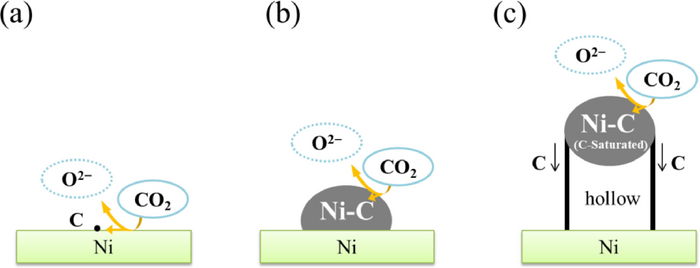Carbon dioxide (CO2) is a primary greenhouse gas produced by different human activities. To reduce humanity’s carbon footprint, researchers and policymakers throughout the world are constantly looking for novel ways to reduce atmospheric CO2 emissions and transform them into useful forms.
 In light of the growing concerns surrounding global warming and carbon footprint, researchers from Japan came up with a technique that could contribute to the development of eco-friendly and sustainable carbon recycling. Image Credit: Takuya Goto from Doshisha University, Japan.
In light of the growing concerns surrounding global warming and carbon footprint, researchers from Japan came up with a technique that could contribute to the development of eco-friendly and sustainable carbon recycling. Image Credit: Takuya Goto from Doshisha University, Japan.
The electrochemical approach of reducing CO2 to other carbonaceous forms, such as carbon monoxide, alcohols, and hydrocarbons has received a lot of interest in this regard.
In this regard, environmental researchers from Doshisha University in Japan, led by Prof. Takuya Goto, illustrated one such technique for transforming CO2 into multi-walled carbon nanotubes (MWCNT) via sustainable electrochemistry using molten salts.
The research includes contributions from Dr. Yuta Suzuki of the Harris Science Research Institute and Mr. Tsubasa Takeda of the Department of Science of Environment and Mathematical Modeling. The study was published in the journal Electrochimica Acta.
The study team used a sustainable electrochemical approach to convert CO2 into MWCNT utilizing LiCl-KCl melt. The molten salts were saturated with CO2 gas, and the electrode was a semi-immersed nickel (Ni) substrate. At the end of the procedure, the provided CO2 was electrochemically transformed into solid carbon. A reduction reaction at the Ni electrode/LiCl-KCl melt/CO2 interface resulted in the green conversion.
The electrochemical reduction of CO2 on a Ni electrode in LiCl-KCl melt at 723 K was studied. Under high polarization, a super meniscus was formed at the three-phase interface of the Ni electrode/LiCl-KCl melt/CO2 gas, where the direct electrochemical reduction of CO2 to solid carbon progressed. Solid carbon was obtained in the wetted area of the Ni electrode as well as in the bulk molten salt via the electrochemical technique.
Takuya Goto, Professor, Doshisha University
After evaluating the electrode-deposited carbon with electron microscopy techniques and elemental analysis, it was discovered that the produced carbonaceous material comprised of MWCNTs, commercially feasible nanostructures with diameters ranging from 30 to 50 nm.
The researchers next modified the applied voltage and the reaction time, observing noticeable changes in the MWCNTs. After increasing the electrolysis time from 10 to 180 minutes, the height of the produced MWCNTs increased.
We studied the dependence of applied potential and electrolytic time on the morphology and crystallinity of the electrodeposited carbon. Based on our experimental results, we proposed a model for the formation of the MWCNTs on the Ni electrode.
Takuya Goto, Professor, Doshisha University
The proposed approach for producing MWCNTs from CO2 is divided into three steps. At the Ni/LiCl-KCl melt/CO2 interface, CO2 is reduced to carbon atoms in the first stage. The electrodeposited carbon atoms create Ni-C compounds (like NiC) on the surface of the Ni electrode during the second stage.
Finally, when the carbon solubility limit in Ni-C compounds is reached, cylindrical-shaped MWCNTs sprout from the edge of the Ni-C compounds produced in the second stage.
In summary, the research identified a unique mechanism for turning CO2 into commercially viable carbonaceous materials sustainably. Furthermore, because no fossil fuels are used, the electrochemical technique used is environmentally sustainable. Furthermore, the utilization of high-temperature molten salts is novel because it allows for the direct conversion of CO2 gas into MWCNTs.
Our results indicate that CO2 can be converted into carbonaceous functional materials. By combining non-consumable oxygen-evolving anodes, this technique can contribute to the development of a carbon recycling technology that will not only solve global environmental problems but also play an important in carbon pricing economies. The material production process, which does not use fossil fuels, will help realize a sustainable society in the near future.
Takuya Goto, Professor, Doshisha University
Journal Reference:
Suzuki, Y., et al. (2023). Direct electrochemical formation of carbonaceous material from CO2 in LiCl-KCl melt. Electrochimica Acta. doi.org/10.1016/j.electacta.2023.142464.